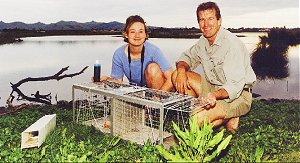|
What's the cat dragging in?  The movements and hunting activities of domestic cats and other mammals in Travis Wetland Nature Heritage Park are being researched.
The movements and hunting activities of domestic cats and other mammals in Travis Wetland Nature Heritage Park are being researched.
"We want to get an idea what impact, if any, domestic cats are having on the wildlife here," says researcher Shelley Morgan, a Lincoln University Master of Science student. The main concern is for breeding birds in the park, including stilts, pukekos and banded dotterels.
Live traps, which catch animals without harming them, are being laid for a few days at a time and checked twice daily. Little tunnels with ink on the floors are also being laid to observe animals' tracks. She is also knocking on doors in the neighbourhood and asking residents about their cats. They needn't fear for the future of their pets, she says. If the research determines there is a problem (with cats killing wildlife), the Council will have to look in the long term at controlling them perhaps with fences or bigger ditches around the park boundaries. Only one other similar study of domestic cat ecology has been done in New Zealand and that was in Auckland. Based on scientific advice from Landcare ecologist Andrea Byrom, the Council is also researching the movements and hunting activities of other predators such as mice and rats, hedgehogs, stoats and ferrets. The Council's Coast Care co-ordinator, Kay Holder, says the Department of Conservation is interested in the research and she is expecting more and more projects to be conducted in Travis Wetland because as a large fresh water wetland within a city, it is unique in New Zealand. Shelley Morgan and Council park ranger Ian "Ned" Surgenor with one of the traps and tunnels in Travis Park. Shelley Morgan is holding a bottle of the blue ink used to see pawprints. |